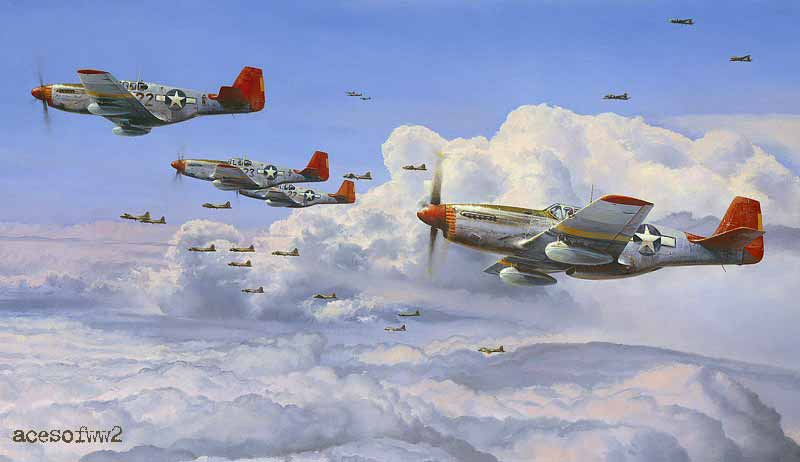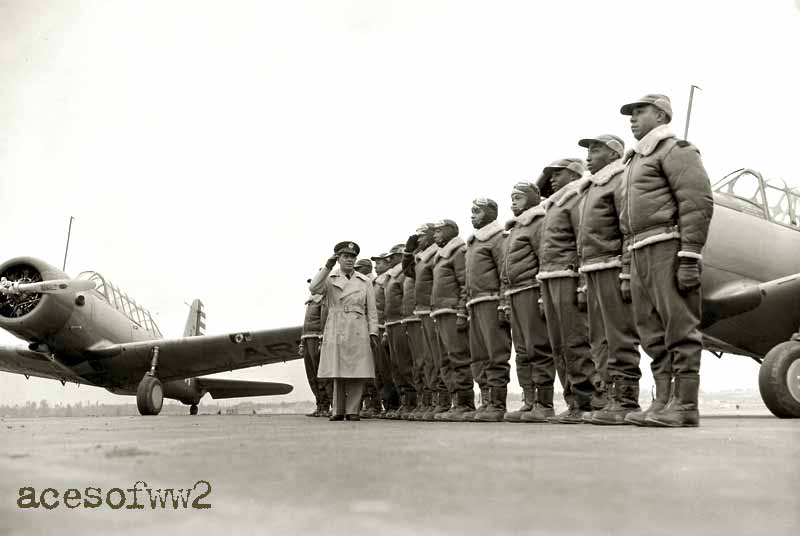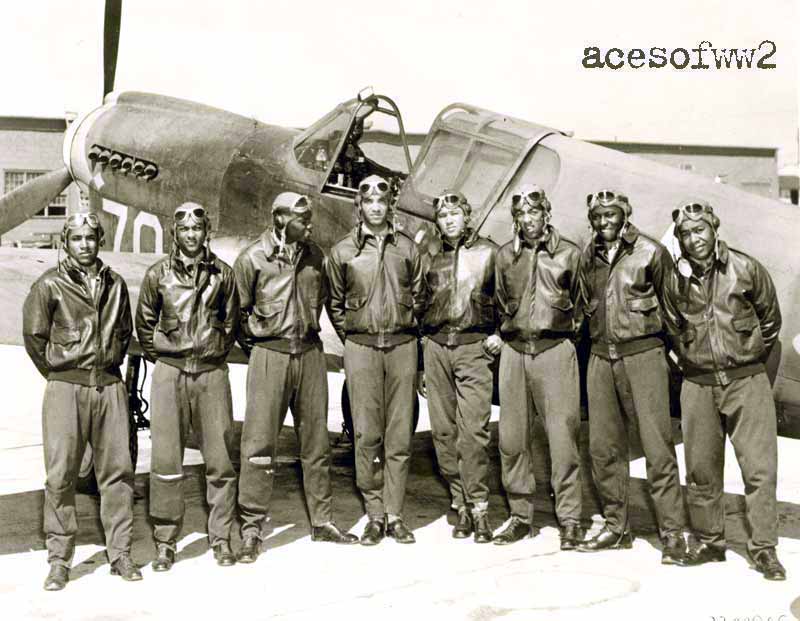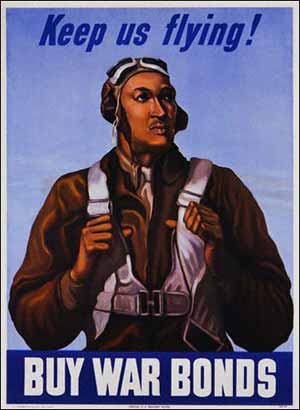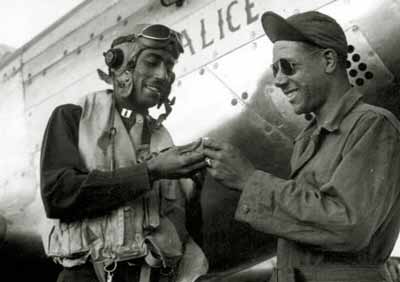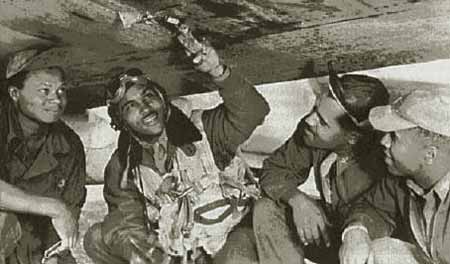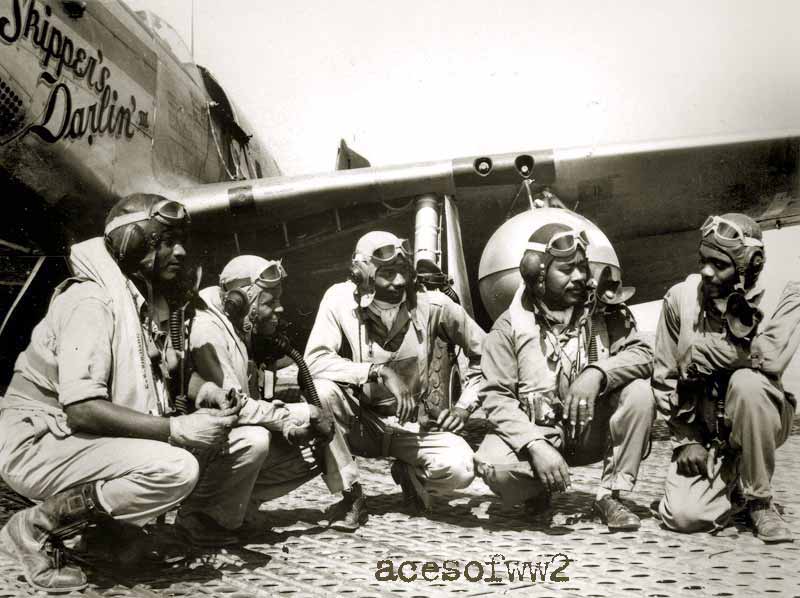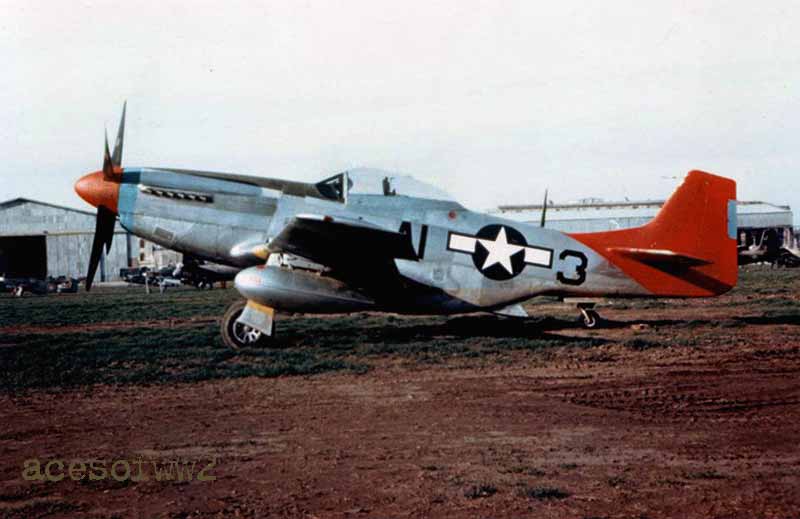|
112 Victories: Aerial Victory Credits of the Tuskegee Airmen
Published by the American Aviation Historical Society, Fall 2008 & reprinted here with permission.
Dr. Haulman used the correct designation "Bf109" but I have used "Me109" as that's what they were called during the war & I like to stay in character.
_________________________________________________
The only African-American pilots in combat with the Army Air Forces during World War II believed they had something to prove. They knew that if they performed well in battle, the decision to accept them in a role from which they had previously been excluded would be vindicated. Excellent combat performance would also contribute to expanding opportunities for African Americans, not only in the armed forces of the United States, but in American society as a whole.
Later known as “Tuskegee Airmen” because they had trained to fly at Tuskegee Army Air Field in Alabama, members of the 332nd Fighter Group and its four squadrons, the 99th, 100th, 301st and 302nd, more than met the challenge. They shot down 112 enemy aircraft in flight. This paper describes that important part of their story. Colonel Benjamin O. Davis, Jr. served as the most famous of the 332nd Fighter Group commanders.
99th Fighter Squadron pilots earned four more aerial victory credits on February 5 and 7, 1944, shooting down German FW 190s raiding Anzio and driving off others. Now the squadron total was 18. By the end of the war, the squadron had also earned three Distinguished Unit Citations. [9]
Former squadron commander Col. Benjamin O. Davis, Jr. had returned to the United States in October 1943 to assume command of the 332nd Fighter Group, the first African-American fighter group. In February 1944, the group moved to the Mediterranean Theater with three assigned squadrons, the 100th, 301st and 302nd. On May 1, the 99th joined the group. [10] Members of the 99th Fighter Squadron would still have the opportunity to shoot down enemy aircraft, but no longer for the 12th Air Force on close air support and interdiction missions. The new mission of the 332nd Fighter Group was to escort heavy bombers of the Fifteenth Air Force on raids against enemy strategic targets in southern and central Europe. They served as one of seven such groups. By the end of May, the group was equipped with P-47 Thunderbolt fighters and settled at Ramitelli Airfield in Italy. [11] On June 9, 1944, Col. Davis led 332nd Fighter Group as it escorted bombers of the 304th Bombardment Wing on a raid to Munich, Germany. Over the Udine area of northeastern Italy, up to 20 enemy fighters challenged the formations, and a series of dogfights ensued. Four of the Tuskegee Airmen shot down five Messerschmitt Me 109s that day. Success was dampened by the fact that one of the Tuskegee flyers failed to return. 332nd Fighter Group commander Col. Benjamin O. Davis, Jr. earned a Distinguished Flying Cross (DFC) for his heroism that day. [12]
As far as aerial victories are concerned, July 18 was the best day yet. The red-tailed Mustangs shot down 12 enemy airplanes, beating the previous one-day record of 10. While escorting 5th Bombardment Wing Boeing B-17 Flying Fortresses on a raid against an airfield at Memmingen, they encountered at least 30 German Me 109s over the Udine and Treviso areas of Italy. The enemy fighters approached from different directions and altitudes in groups of two and five. Most of the day’s victories belonged to the 21 Tuskegee Airmen P-51s that engaged these German aircraft, but the P-51s that continued to the target area also shot down two of four FW 190s that dove on the bomber formations over Memmingen. Three of the group’s pilots went missing that day. [17] On July 20, 1944, the 332nd Fighter Group escorted heavy bombers of three wings to their targets in the Friedrichshafen area of Germany. They also conducted a fighter sweep northeast of the target. Of the 44 P-51 escorts on the raid, 20 peeled off to engage an equal number of fighters that attacked the rear wave of bombers in the Udine area. The Tuskegee pilots shot down four Me 109s. No Tuskegee Airmen fell that day. [18]
The day was not unmitigated triumph for the Americans, however. One of the jets shot the right wing off a P-51, and its pilot, Capt. Armour G. McDaniel, went down. [31] In terms of aerial victory credits, the best day for the Tuskegee Airmen was March 31, 1945. Members of the 332nd Fighter Group shot down 13 airplanes, the most since the 12 they got on July 18, 1944. The red-tailed Mustangs were conducting a fighter sweep of the Munich area and strafing rail targets in southern Germany when they were challenged by German Me 109s and FW 190s. Six members of the 99th Fighter Squadron shot down five Me 109s and one FW 190, all of the enemy fighters that challenged them in their assigned western sector of the target area. The 100th Fighter Squadron also produced six victors that day. They shot down five FW 190s and two Me 109s. The 11 enemy fighters that challenged the 100th Fighter Squadron in its eastern sector of the target area were more aggressive than those that confronted the 99th, and four got away. [32]
On April 1, the primary mission of the 332nd Fighter Group was to escort B-24s raiding St. Polten marshalling yard. Eight of the 47 red-tailed P-51s that launched preceded the bombers and then flew a fighter sweep of the Linz area of Austria. Flying at an altitude of 5,000 feet, the Mustang pilots spotted four FW 190s near Wels flying in the same direction but about 2,000 feet below them. They dived to attack, but at that point, 12 additional enemy aircraft appeared from a higher altitude. A series of individual dogfights ensued, ranging from altitudes of 5,000 feet to the deck. The enemy pilots attempted to out-turn the P-51s or to lead them over antiaircraft artillery. Seven members of the 301st Fighter Squadron shot down 12 enemy airplanes that day, including eight FW 190s and four Me 109s. Unfortunately, three of the P-51s failed to return. [33] On April 15, the 332nd Fighter Group launched 37 P-51s to strafe rail targets in southern Germany and Austria. Mustangs of the 99th, 100th and 301st Fighter Squadrons each took a separate area. While two of the 301st pilots were strafing rail traffic, they spotted a Me 109 and chased him. 1st Lt. Jimmy Lanham’s shots hit the enemy aircraft in the engine and it burst into flames before crashing into the ground. Four of the Tuskegee pilots failed to return to Ramitelli that day, but they were not all lost. Two landed at alternate fields. [34] The final day for Tuskegee Airmen aerial victories was April 26. Three of six group P-51s escorting a reconnaissance airplane peeled off to investigate an unidentified aircraft that turned out to be an Allied Mosquito. On their way back, they encountered five Me 109s that rocked their wings to appear to be friendly. Not fooled, the Mustang pilots turned toward the enemy, who took evasive action. Only one of the Me 109s escaped. A few days later, the war ended. [35]
During World War II, 72 Tuskegee Airmen shot down 112 enemy aircraft, including the best of the German fighters. Members of the 332nd Fighter Group downed at least 10 airplanes on four separate days in 1944 and 1945. Three of the Tuskegee Airmen, the 301st Fighter Squadron’s Capt. Joseph D. Elsberry, the 99th Fighter Squadron’s Capt. Edward L. Toppins and the 302nd Fighter Squadron’s Lt. Lee A. Archer, each shot down four enemy planes. On most missions, the group escorted heavy bombers of the Fifteenth Air Force on raids against targets in Germany, Austria, and other parts of central Europe. The Tuskegee Airmen proved that African-Americans were capable of flying the best of the Allied fighters to victory against the best of the enemy fighters. They earned an indelible place in the history not only of their service, but also in the history of their country and of the world. [36] |
|||||||||||||||||||||||||||||
_________________________________________________
Tuskegee Airmen With More Than One Claim
 |
Joseph D. Elsberry | (301st) 4 / 1 / 0 |
 |
Edward L. Toppins | (99th) 4 / 1 / 0 |
|
 |
"Buddy" Lee Andrew Archer Jr. |
(302nd) 4 / 0 / 0 |
 |
Charles B. Hall | (99th) 3 / 0 / 0 |
|
 |
Leonard M. Jackson | (99th) 3 / 0 / 0 |
 |
"Lucky" Clarence D. Lester |
(100th) 3 / 0 / 0 |
|
 |
Wendell O. Pruitt | (302nd) 3 / 0 / 0 |
 |
Roger Romine | (302nd) 3 / 0 / 1 |
|
 |
Harry T. Stewart Jr. | (301st)
3 / 0 / 0 |
 |
Edward Creston Gleed | (301st) 2 / 0 / 1 |
|
 |
Robert W. Williams | (100th) 2 / 0 / 1 |
 |
Roscoe C. Brown | (100th) 2 / 0 / 0 |
|
 |
Carl Edward Carey | (301st)
2 / 0 / 0 |
 |
Robert W. Deiz | (99th)
2 / 0 / 0 |
|
 |
Wilson Vash Eagleson II | (99th)
2 / 0 / 0 * |
 |
John Ellis Edwards | (301st)
2 / 0 / 0 |
|
 |
* Frederick Douglas Funderburg Jr. | (301st, MIA 19dec44) 2 / 0 / 0 |
 |
William W. Green Jr. | (302nd)
2 / 0 / 0 |
|
 |
Alfred M. Gorham | (301st) 2 / 0 / 0 |
 |
Thomas W. Jefferson | (301st)
2 / 0 / 0 |
|
 |
Jack D. Holsclaw | (100th) 2 / 0 / 0 |
 |
Luther H. Smith Jr. | (302nd)
2 / 0 / 0 |
|
 |
Jimmy Lanham | (301st) 2 / 0 / 0 * |
 |
Charles L. White | (301st)
2 / 0 / 0 |
|
 |
Luke J. Weathers Jr. | (302nd) 2 / 0 / 0 * |
 |
Howard L. Baugh | (99th)
1.5 / 0 / 0 * |
|
(Frank Olynyk gives him 0.5 / 0 / 1) |
||||||
_________________________________________________
CHRONOLOGICAL TABLE OF TUSKEGEE AIRMEN AERIAL VICTORY CREDITS
| |
|
|
|
General Order # |
|---|---|---|---|---|
| 2 July 1943 | 1Lt Charles B. Hall | 1 FW 190 | 32 XII ASC 7-Sep-43 |
|
| 27 Jan 1944 | 2Lt Clarence W. Allen | ½ FW 190 | 66 XII AF 24-May-44 |
|
| 1Lt Willie Ashley Jr. | 1 FW 190 | 122 XII AF 7-Aug-44 |
||
| 2Lt Charles P. Bailey | 1 FW 190 | 66 XII AF 24-May-44 |
||
| 1Lt Howard Baugh | 1 FW 190 | 122 XII AF 7-Aug-44 |
||
| ½ FW 190 | 66 XII AF 24-May-44 |
|||
| Capt Lemuel R. Custis | 1 FW 190 | 122 XII AF 7-Aug-44 |
||
| 1Lt Robert W. Deiz | 1 FW 190 | 66 XII AF 24-May-44 |
||
| 2Lt Wilson V. Eagleson | 1 FW 190 | 66 XII AF 24-May-44 |
||
| 1Lt Leon C. Roberts | 1 FW 190 | 122 XII AF 7-Aug-44 |
||
| 2Lt Lewis C. Smith | 1 FW 190 | 66 XII AF 24-May-44 |
||
| 1Lt Edward L. Toppins | 1 FW 190 | 81 XII AF 22-Jun-44 |
||
| 28 Jan 1944 | 1Lt Robert W. Deiz | 1 FW 190 | 122 XII AF 7-Aug-44 |
|
| Capt Charles B. Hall | 1 FW 190 | & |
||
| 1 Me 109 | 64 XII AF 22-May-44 |
|||
| 5 Feb 1944 | 1Lt Elwood T. Driver | 1 FW 190 | 66 XII AF 24-May-44 |
|
| 7 Feb 1944 | 2Lt Wilson V. Eagleson | 1 FW 190 | 122 XII AF 7-Aug-44 |
|
| 2Lt Leonard M. Jackson | 1 FW 190 | 66 XII AF 24-May-44 |
||
| 1Lt Clinton B. Mills | 1 FW 190 | 66 XII AF 24-May-44 |
||
| 9 Jun 1944 | 1Lt Charles M. Bussy | 1 Me 109 | 1473 XV AF 30-Jun-44 |
|
| 2Lt Frederick D. Funderburg | 2 Me 109s | 1473 XV AF 30-Jun-44 |
||
| 1Lt Melvin T. Jackson | 1 Me 109 | 1473 XV AF 30-Jun-44 |
||
| 1Lt Wendell O. Pruitt | 1 Me 109 | 1473 XV AF 30-Jun-44 |
||
| 12 Jul 1944 | 1Lt Harold E. Sawyer | 1 FW 190 | 2032 XV AF 23-Jul-44 |
|
| 1Lt. Joseph D. Elsberry | 3 FW 190s | 2466 XV AF-Aug-44 |
||
| 16 Jul 1944 | 1Lt Alfonza W. Davis | 1 MA-205 | 2030 XV AF 23-Jul-44 |
|
| 2Lt William W. Green Jr | 1 MA-202 | 2029 XV AF 23-Jul-44 |
||
| 17 Jul 1944 | 1Lt Luther H. Smith Jr. | 1 Me 109 | 2350 XV AF 6-Aug-44 |
|
| 2Lt Robert H. Smith | 1 Me 109 | 2350 XV AF 6-Aug-44 |
||
| 1Lt Laurence D. Wilkins | 1 Me 109 | 2350 XV AF 6-Aug-44 |
||
| 18 Jul 1944 | 2Lt Lee A. Archer | 1 Me 109 | 2350 XV AF 6-Aug-44 |
|
| 1Lt Charles P. Bailey | 1 FW 190 | 2484 XV AF 11-Aug-44 |
||
| 1Lt Weldon K. Groves | 1 Me 109 | 2350 XV AF 6-Aug-44 |
||
| 1Lt Jack D. Holsclaw | 2 Me 109s | 2202 XV AF 31-Jul-44 |
||
| 2Lt Clarence D. Lester | 3 Me 109s | 2202 XV AF 31-Jul-44 |
||
| 2Lt Walter J. A. Palmer | 1 Me 109 | 2202 XV AF 31-Jul-44 |
||
| 2Lt Roger Romine | 1 Me 109 | 2350 XV AF 6-Aug-44 |
||
| Capt Edward L. Toppins | 1 FW 190 | 2484 XV AF 11-Aug-44* |
||
| 2Lt Hugh S. Warner | 1 Me 109 | 2350 XV AF 6-Aug-44 |
||
| 20 Jul 1944 | Capt Joseph D. Elsberry | 1 Me 109 | 2284 XV AF 3-Aug-44 |
|
| 1Lt Langdon E. Johnson | 1 Me 109 | 2202 XV AF 31-Jul-44 |
||
| Capt Armour G. McDaniel | 1 Me 109 | 2284 XV AF 3-Aug-44 |
||
| Capt Edward L. Toppins | 1 Me 109 | 2484 XV AF 11-Aug-44 |
||
| 25 Jul 1944 | 1Lt Harold E. Sawyer | 1 Me 109 | 2284 XV AF 3-Aug-44 |
|
| 26 Jul 1944 | 1Lt Freddie E. Hutchins | 1 Me 109 | 2350 XV AF 6-Aug-44 |
|
| 1Lt Leonard M. Jackson | 1 Me 109 | 2484 XV AF 11-Aug-44 |
||
| 2Lt Roger Romine | 1 Me 109 | 2350 XV AF 6-Aug-44 |
||
| Capt Edward L. Toppins | 1 Me 109 | 2484 XV AF 11-Aug-44 |
||
| 27 Jul 1944 | 1Lt Edward C. Gleed | 2 FW 190s | 2284 XV AF 3-Aug-44 |
|
| 2Lt Alfred M. Gorham | 2 FW 190s | 2284 XV AF 3-Aug-44 |
||
| Capt Claude B. Govan | 1 Me 109 | 2284 XV AF 3-Aug-44 |
||
| 2Lt Richard W. Hall | 1 Me 109 | 2485 XV AF 11-Aug-44 |
||
| 1Lt Leonard M. Jackson | 1 Me 109 | 2484 XV AF 11-Aug-44 |
||
| 1Lt Felix J. Kirkpatrick | 1 Me 109 | 2350 XV AF 6-Aug-44 |
||
| 30 July 1944 | 2Lt Carl E. Johnson | 1 RE-2001 | 2485 XV AF 11-Aug-44 |
|
| 14 Aug 1944 | 2Lt George M. Rhodes Jr. | 1 FW 190 | 2831 XV AF 25-Aug-44 |
|
| 23 Aug 1944 | FO William L. Hill | 1 Me 109 | 3538 XV AF 21-Sep-44 |
|
| 24 Aug 1944 | 1Lt John F. Briggs | 1 Me 109 | 3153 XV AF 6-Sep-44 |
|
| 1Lt Charles E. McGee | 1 FW 190 | 3174 XV AF 7-Sep-44 |
||
| 1Lt William H. Thomas | 1 FW 190 | 449 XV AF 31-Jan-45 |
||
| 12 Oct 1944 | 1Lt Lee A. Archer | 3 Me 109s | 4287 XV AF 1-Nov-44 |
|
| Capt Milton R. Brooks | 1 Me 109 | 4287 XV AF 1-Nov-44 |
||
| 1Lt William W. Green Jr. | 1 He 111 | 4287 XV AF 1-Nov-44 |
||
| Capt Wendell O. Pruitt | 1 He 111 | & |
||
| 1 Me 109 | 4287 XV AF 1-Nov-44 |
|||
| 1Lt Roger Romine | 1 Me 109 | 4287 XV AF 1-Nov-44 |
||
| 1Lt Luther H. Smith Jr. | 1 He 111 | 4604 XV AF 21-Nov-44 |
||
| 16 Nov 1944 | Capt Luke J. Weathers | 2 Me 109s | 4990 XV AF 13-Dec-44 |
|
| 16 Mar 1945 | 1Lt William S. Price III | 1 Me 109 | 1734 XV AF 24-Mar-45 |
|
| 24 Mar 1945 | 2Lt Charles V. Brantley | 1 Me 262 | 2293 XV AF 12-Apr-45 |
|
| 1Lt Roscoe C. Brown | 1 Me 262 | 2293 XV AF 12-Apr-45 |
||
| 1Lt Earl R. Lane | 1 Me 262 | 2293 XV AF 12-Apr-45 |
||
| 31 Mar 1945 | 2Lt Raul W. Bell | 1 FW 190 | 2293 XV AF 12-Apr-45 |
|
| 2Lt Thomas P. Brasswell | 1 FW 190 | 2292 XV AF 12-Apr-45 |
||
| 1Lt Roscoe C. Brown | 1 FW 190 | 2293 XV AF 12-Apr-45 |
||
| Maj William A. Campbell | 1 Me 109 | 2292 XV AF 12-Apr-45 |
||
| 2Lt John W. Davis | 1 Me 109 | 2292 XV AF 12-Apr-45 |
||
| 2Lt James L. Hall | 1 Me 109 | 2292 XV AF 12-Apr-45 |
||
| 1Lt Earl R. Lane | 1 Me 109 | 2293 XV AF 12-Apr-45 |
||
| FO John H. Lyle | 1 Me 109 | 2293 XV AF 12-Apr-45 |
||
| 1Lt Daniel L. Rich | 1 Me 109 | 2292 XV AF 12-Apr-45 |
||
| 2Lt Hugh J. White | 1 Me 109 | 2292 XV AF 12-Apr-45 |
||
| 1Lt Robert W. Williams | 2 FW 190s | 2293 XV AF 12-Apr-45 |
||
| 2Lt Bertram W. Wilson Jr. | 1 FW 190 | 2293 XV AF 12-Apr-45 |
||
| 1 Apr 1945 | 2Lt Carl E. Carey | 2 FW 190s | 2294 XV AF 12-Apr-45 |
|
| 2Lt John E. Edwards | 2 Me 109s | 2294 XV AF 12-Apr-45 |
||
| FO James H. Fischer | 1 FW 190 | 2294 XV AF 12-Apr-45 |
||
| 2Lt Walter P. Manning | 1 FW 190 | 2294 XV AF 12-Apr-45 |
||
| 2Lt Harold M. Morris | 1 FW 190 | 2294 XV AF 12-Apr-45 |
||
| 1Lt Harry T. Stewart | 3 FW 190s | 2294 XV AF 12-Apr-45 |
||
| 1Lt Charles L. White | 2 Me 109s | 2294 XV AF 12-Apr-45 |
||
| 15 Apr 1945 | 1Lt Jimmy Lanham | 1 Me 109 | 3484 XV AF 29-May-45 |
|
| 26 Apr 1945 | 2Lt Thomas W. Jefferson | 2 Me 109s | 3362 XV AF 23-May-45 |
|
| 1Lt Jimmy Lanham | 1 Me 109 | 3362 XV AF 23-May-45 |
||
| 2Lt Richard A. Simons | 1 Me 109 | 2990 XV AF 4-May-45 |
* order says credit was 16 Jul 1944, but history says 18 Jul 1944
________________________________________________
References[1] Biographies of Generals Benjamin O. Davis, Sr. and Benjamin O. Davis, Jr. in the official biographies file of the Research Division of the Air Force Historical Research Agency; John L. Frisbee, “Out of the Wilderness,” Air Force Magazine, March 1985, 121. Harry R. Fletcher, Lineage and Honors History of the 99th Flying Training Squadron, prepared on May 23, 1988 at the USAF Historical Research Center, later the Air Force Historical Research Agency, Maxwell AFB, Alabama. [2] Fletcher. Maurer, Combat Squadrons, 329-330. Robert Goralski, World War II Almanac: 1931-1945 (New York: G. P. Putnam’s Sons, 287-288; Herman S. Wolk, “Pantelleria, 1943,” Air Force Magazine, vol. 85 no. 6 (June 2002), 64-68. [3] XII Air Support Command General Order 32, September 7, 1943. Charlie and Ann Cooper, Tuskegee’s Heroes (Osceola, Wis.: Motorbooks International, 1996), 75. [4] Alan L. Gropman, The Air Force Integrates, 1945-1964 (Washington, D.C.: Office of Air Force History, 1978), 12-14; http://www.aviation-history.com/airmen/davis.htm Cooper, 77-79. [5] Fletcher. Maurer, Air Force Combat Units, 144-145. [6] Kit C. Carter and Robert Mueller, The Army Air Forces in World War II: Combat Chronology, 1941-1945 (Washington D.C.: Office of Air Force History, 1973), 256; Goralski, 301-302; Maurer Air Force Combat Units, 205-206. [7] Twelfth Air Force General Order 64, May 22, 1944; Twelfth Air Force General Order 66, May 24, 1944; Twelfth Air Force General Order 81, June 22, 1944; Twelfth Air Force General Order 122, August 7, 1944. [8] USAF Historical Study 85, 413-414; Maurer, Air Force Combat Units, 83-87, 144-145, 205-206; Maurer, Combat Squadrons, 230-231, 295, 297-300, 329-330, 371-373, 385; Benjamin O. Davis, Jr., Benjamin O. Davis, Jr., American (Washington D.C.: Smithsonian Institution Press, 1991), 114. [9] Twelfth Air Force General Order 66, May 24, 1944; Twelfth Air Force General Order 122, August 7, 1944; Maurer, Combat Squadrons, 329-330. [10] Maurer, Air Force Combat Units, 212-213; Maurer, Combat Squadrons, 329-330. [11] Charles A. Ravenstein, The Organization and Lineage of the United States Air Force (Washington, D.C.: Office of Air Force History, 1986), 33-35; Maurer, Air Force Combat Units, 213. [12] Fifteenth Air Force General Order 1473, June 30, 1944; 332 Fighter Group history, June 1944 (GP-332-HI June 1944 at the Air Force Historical Research Agency); Davis, 122-123; Missing Air Crew Reports numbered 6317 and 6179; Fifteenth Air Force General Order 2972, August 31, 1944, AFHRA call number 670.193. [13] Fifteenth Air Force General Orders 2029, 2030, and 2032, all dated July 23, 1944; Fifteenth Air Force General Order 2202, July 31, 1944; Fifteenth Air Force General Order 2284, August 3, 1944; Fifteenth Air Force General Order 2350, Aug 6, 1944, and Fifteenth Air Force General Orders 2484 and 2485, both dated August 11, 1944. 332 Fighter Group history, July 1944 (GP-332-HI July 1944 at the Air Force Historical Research Agency). [14] Fifteenth Air Force General Order 2032, July 23, 1944; 332 Fighter Group history, July 1944, including 332 Fighter Group narrative mission report 23, July 12, 1944 and supplement to that report; 461st Bombardment Group mission report for July 12, 1944; Fifteenth Air Force mission folder for July 12, 1944; missing air crew reports 6808, 6894, 6895, and 7034; Fifteenth Air Force General Order 2466, August 10, 1944. [15] Fifteenth Air Force General Orders 2029 and 2030, both dated July 23, 1944; 332 Fighter Group History, July 1944; 332 Fighter Group mission report 26, July 16, 1944. [16] Fifteenth Air Force General Order 2350, August 6, 1944; 332 Fighter Group history, July 1944; 322 Fighter Group mission report 27, July 17, 1944; Davis, 123. [17] Fifteenth Air Force General Order 2350, August 6, 1944; Fifteenth Air Force General Order 2484, August 11, 1944; Fifteenth Air Force General Order 2202, July 31, 1944; 332 Fighter Group History, July 1944; 332 Fighter Group Mission Report 28, July 18, 1944; Fifteenth Air Force Mission Folder for July 18, 1944, AFHRA call number 670.332; Missing Air Crew Report numbers 6856, 6953, 6954, 6975, 6976, 6977, 6978, 6979, 6980, 6981, 7097, 7098, 7099, 7153, and 7310. [18] Fifteenth Air Force General Order 2202, July 31, 1944; Fifteenth Air Force General Order 2284, August 3, 1944; Fifteenth Air Force General Order 2484, August 11, 1944; 332 Fighter Group History, July 1944; 332 Fighter Group Mission Report 30, July 20, 1944; Missing Air Crew Reports numbered 6914 and 6919. [19] 332 Fighter Group History, July 1944; 332 Fighter Group Mission Reports 33 and 34. [20] 332 Fighter Group History, July 1944; 332 Fighter Group Mission Report 36. [21] Fifteenth Air Force General Order 2350, August 6, 1944; Fifteenth Air Force General Order 2484, August 11, 1944; 332 Fighter Group history, July 1944; 332 Fighter Group mission report 37, July 26, 1944. [22] Fifteenth Air Force General Order 2284, August 3, 1944; Fifteenth Air Force General Order 2350, August 6 ,1944; Fifteenth Air Force General Order 2484, August 11, 1944; Fifteenth Air Force General Order 2485 also, August 11, 1944; 332 Fighter Group history, July 1944; 332 Fighter Group mission report 38, July 27, 1944. [23] Fifteenth Air Force General Order 2485, August 11, 1944; 332 Fighter Group History, July 1944; 332 Fighter Group mission report 40, July 30, 1944. [24] Fifteenth Air Force General Order 2831, August 25, 1944; 332 Fighter Group history, August 1944; 332 Fighter Group mission report 51, August 14, 1944. [25] Fifteenth Air Force General Order 3538, September 21, 1944; 332 Fighter Group history, August 1944; 332 Fighter Group mission report 60, August 23, 1944, and its supplement. [26] Fifteenth Air Force General Order 3153, September 6, 1944; Fifteenth Air Force General Order 3174, September 7, 1944; Fifteenth Air Force General Order 449, January 31, 1945; 332 Fighter Group history, August 1944; 332 Fighter Group mission report 61, August 24, 1944. [27] Fifteenth Air Force General Order 4287, November 1, 1944; Fifteenth Air Force General Order 4604, November 21, 1944; 332 Fighter Group history, Oct 1944; 332 Fighter Group narrative mission report 92, Oct 12, 1944, and supplement to that report; Davis, 130. [28] Fifteenth Air Force General Order 4990, December 13, 1944; 332 Fighter Group History, November 1944; 332 Mission Report 119, November 16, 1944; Davis, 130. [29] 332 Fighter Group histories, January and February 1945. [30] Fifteenth Air Force General Order 1734, March 24, 1945; 332 Fighter Group history, March 1945; 332 Fighter Group mission report 227, March 16, 1945. [31] Fifteenth Air Force General Order 2293, April 12, 1945; 332 Fighter Group history, March 1945; 332 Fighter Group mission report 246, March 24, 1945; Karen Leverington, Fighting Aircraft of World War II (Shrewsbury, England: Airlife, 1995) 81, 83, 99; Davis, 133; Fifteenth Air Force mission folder for March 24, 1945; Mission reports of the 2, 463, and 483 Bombardment Groups for March 24, 1945; Missing air crew reports 13278, 13274, 13375, 13374, and 13271. [32] Fifteenth Air Force General Orders 2292 and 2293, April 12, 1945; 332 Fighter Group history, March 1945; 332 Fighter Group mission report 252, March 31, 1945; Davis, 133-134. [33] Fifteenth Air Force General Order 2294, April 12, 1945; 332 Fighter Group history, April 1945; 332 Fighter Group mission report 253, April 1,1945; Davis, 134. [34] Fifteenth Air Force General Order 3484, May 29, 1945; 332 Fighter Group history, April 1945; 332 Fighter Group mission report 282, April 15, 1945. [35] Fifteenth Air Force General Order 2990, May 4, 1945; Fifteenth Air Force General Order 3362, May 23, 1945; 332 Fighter Group history, April 1945; 332 Fighter Group mission report 309, April 26, 1945; Davis, 135. [36] Maurer, Air Force Combat Units of World War II (Washington, D.C.: Office of Air Force History, 1983), 212-213; Maurer Maurer, Combat Squadrons of the Air Force, World War II (Washington, D.C.: USAF Historical Division, 1969), 329-330, 332, 365, 366; USAF Historical Study No. 85. |
_________________________________________________
American Aviation Historical Society
Other Works by Dr. Dan Haulman at New South Books
Complete list of all Tuskegee flyers (not there any more)
_______________________________________________________________
The painting "Fighting Red Tails" by Robert Taylor, found at the top of this page, was not used in the original article which featured a photograph of a P-51 restored as a 301 FS Mustang. I've also added to the article the photo of Hall, the War Bonds poster & the photos marked as Air Force photos. AND, that little list above with the pictures of pilots with more than one kill - I threw that in too.
Some content on this site is probably the property of acesofww2.com unless otherwise noted.
![]()

